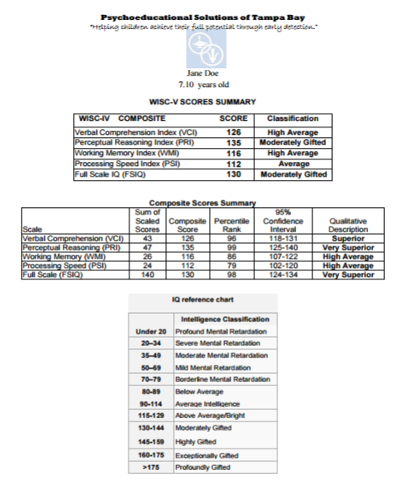Expert Guide to the WISC IQ Test for Children
/What is the WISC IQ Test?
Intended to assess general intelligence, the Wechsler Intelligence Scale for Children, or WISC IQ test, has been designed for use in children between the ages of 6 and sixteen.
Created in 1949, it’s now one of the most widely used intelligence tests in the industry. Just like its sister test, the Wechsler Adult Intelligence Test (WAIS), the WISC was developed by famed psychologist David Wechsler, and owned by Pearson Clinical.
Some gifted schools, such as ACE Academy or Atlanta Gifted Academy, require that a WISC score be submitted as part of the application packet. Additionally, the exam can be utilized to identify the presence of developmental disabilities, giftedness, or attention disorders.
Currently, as the test is in its fifth edition, you may see it referred to as the WISC-V.
What Does the WISC Measure?
The WISC IQ Test measures an individual’s verbal and non-verbal intelligence across a wide variety of parameters. However, the term “intelligence” possessed a unique definition to the test’s creator. Wechsler does not believe in measuring a person’s total mental capacity. Instead, his test focuses wholly on performance-based metrics. Additionally, he believed intellect to be a multi-dimensional scale with a wide variety of determining characteristics. In summary, the WISC has been designed to measure how well a child performs when challenges are posed to their verbal and non-verbal capacities.
To be more specific, the exam will assess your child in the following areas:
How is the WISC IQ Formatted?
The WISC IQ test will be administered by trained examiners over a time of approximately ninety minutes. This time will vary depending on the subtests and options selected prior to starting the exam. Depending on your preferences, the WISC can be taken in both digital and hard copy formats. The administration of the exam take places in a one-to-one setting.
What Question Types Are On The WISC-V?
In addition to ancillary and secondary subtests, which will not be covered here, the WISC IQ test has 10 primary question types:
How Will My Child’s WISC IQ Test Be Scored?
sample WISC SCORE CHART
Your child’s test scores will be evaluated based on predetermined norms and the time it took them to complete the given subtests. Bonuses given for quick question completion can greatly impact a child’s final score.
The first number shown, the overall IQ score, will be the one most commonly used in the admissions process for charter and gifted schools. Most gifted schools require WISC-V composite scores above the “average” level:
In addition to their intelligence quotient, each subtest will be scored separately. You must analyze this set of numbers, such as the Verbal Comprehension Index (VCI) scaled score, to determine how well your child did in any given subject. This provides an excellent screenshot of their strengths and weaknesses.
Lastly, to improve your ability to make comparisons, all score sheets will include a percentile ranking. This figure will be given for both the composite and individual subtests. This number will tell you what percentage of similar test takers performed at, or below, a child’s final score.
Why Should My Child Take the WISC IQ Test?
As one of the oldest and most up-to-date IQ tests on the market, the WISC is known to be both valid and verifiable. For that reason, it’s used by a wide variety of schools as a go-to admission’s test.
In addition to potentially providing your child a brighter academic future, the results will provide an enhanced understanding of a person’s strengths and weaknesses.
How Should I Help My Child Prepare for the WISC IQ Test?
Just because the WISC IQ test measures the innate, doesn’t mean that you should trust your child’s score to a toss of the dice. By familiarizing a child with the test ahead of time, you can ensure that questions they miss have nothing to do with unfamiliar formatting. You can find a variety of example WISC IQ test questions with a simple Google search (or just by downloading our own set of them). Try to complete a few full practice exams before practice day.
In addition to practice, following these tips to help your child perform his or her best come exam day:
Learn more about similar tests to the WISC IQ test that highly-selective schools require prospective students to take to gain admission, including the Stanford-Binet, OLSAT-8 achievement test, NNAT, and Cogat.


